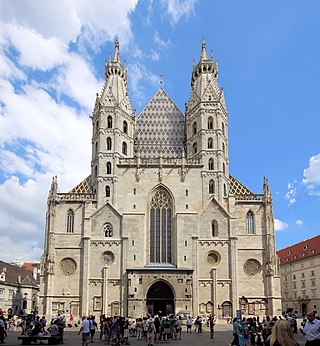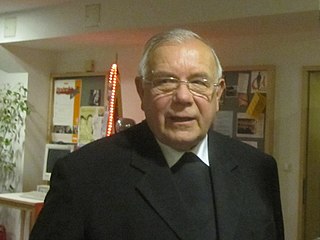
The Church of England is the established Christian church in England. It traces its history to the Christian church recorded as existing in the Roman province of Britain by the 3rd century and to the 6th-century Gregorian mission to Kent led by Augustine of Canterbury. Its adherents are called Anglicans.

Linz is the capital of Upper Austria and third-largest city in Austria. In the north of the country, it is on the Danube 30 km (19 mi), south of the Czech border. In 2018, the population was 204,846.

There have been many cases of sexual abuse of children by priests, nuns, and other members of religious life in the Catholic Church. In the 20th and 21st centuries, the cases have involved many allegations, investigations, trials, convictions, acknowledgement and apologies by Church authorities, and revelations about decades of instances of abuse and attempts by Church officials to cover them up. The abused include mostly boys but also girls, some as young as three years old, with the majority between the ages of 11 and 14. Criminal cases for the most part do not cover sexual harassment of adults. The accusations of abuse and cover-ups began to receive public attention during the late 1980s. Many of these cases allege decades of abuse, frequently made by adults or older youths years after the abuse occurred. Cases have also been brought against members of the Catholic hierarchy who covered up sex abuse allegations and moved abusive priests to other parishes, where abuse continued.
Kulturkampf was a fierce conflict that took place from 1872 to 1878 between the Catholic Church led by Pope Pius IX and the government of Prussia led by Otto von Bismarck. The main issues were clerical control of education and ecclesiastical appointments. A unique feature of Kulturkampf, compared to other struggles between the state and the Catholic Church in other countries, was Prussia's anti-Polish component. By extension the term Kulturkampf is sometimes used to describe any conflict between secular and religious authorities, or deeply opposing values and beliefs between sizable factions within a nation, community, or other group.
Gallicanism is the belief that popular civil authority—often represented by the monarch's or the state's authority—over the Catholic Church is comparable to that of the Pope. Gallicanism is a rejection of ultramontanism; it has something in common with Anglicanism, but is nuanced, in that it plays down the authority of the Pope in church without denying that there are some authoritative elements to the office associated with being primus inter pares. Other terms for the same or similar doctrines include Erastianism, Febronianism, and Josephinism.

The Reichskonkordat is a treaty negotiated between the Vatican and the emergent Nazi Germany. It was signed on 20 July 1933 by Cardinal Secretary of State Eugenio Pacelli, who later became Pope Pius XII, on behalf of Pope Pius XI and Vice Chancellor Franz von Papen on behalf of President Paul von Hindenburg and the German government. It was ratified 10 September 1933 and it has been in force from that date onward. The treaty guarantees the rights of the Catholic Church in Germany. When bishops take office Article 16 states they are required to take an oath of loyalty to the Governor or President of the German Reich established according to the constitution. The treaty also requires all clergy to abstain from working in and for political parties. Nazi breaches of the agreement began almost as soon as it had been signed and intensified afterwards leading to protest from the Church including in the 1937 Mit brennender Sorge encyclical of Pope Pius XI. The Nazis planned to eliminate the Church's influence by restricting its organizations to purely religious activities.

The Catholic Church, also known as the Roman Catholic Church, is the largest Christian church, with 1.3 billion baptized Catholics worldwide as of 2019. It is among the world's oldest and largest international institutions, and has played a prominent role in the history and development of Western civilization. The church consists of 24 sui iuris churches, including the Latin Church and 23 Eastern Catholic Churches, which comprise almost 3,500 dioceses and eparchies located around the world. The pope, who is the bishop of Rome, is the chief pastor of the church. The bishopric of Rome, known as the Holy See, is the central governing authority of the church. The administrative body of the Holy See, the Roman Curia, has its principal offices in Vatican City, a small enclave of the Italian city of Rome, of which the pope is head of state.
Christine Mayr-Lumetzberger is a teacher and former Benedictine nun who was excommunicated from the Roman Catholic Church when she and six others were ordained as priests by an Independent Catholic bishop in 2002, she called herself a Roman Catholic priest, and she refused to recant. She was ordained a bishop in 2003 along with Gisela Forster; reportedly, the ordination was performed by Roman Catholic bishops whose identity remains a secret.
The first conflicts between the Roman Catholic Church and the Argentine government can be traced to the ideas of the May Revolution of 1810. The Tribunal of the Inquisition was suppressed in the territories of the United Provinces of the River Plate on 23 March 1813, and on 4 June the General Assembly declared the state "independent from any ecclesiastical authorities existing outside its territory".

The New Cathedral, also known as the Cathedral of the Immaculate Conception, is a Roman Catholic cathedral located in Linz, Austria. The neo-Gothic church is the largest, though not the tallest church in Austria.

The Catholic Church in Austria is part of the worldwide Catholic Church in full communion with the Pope in Rome. The Church's governing body in Austria is the Austrian Conference of Catholic Bishops, made up of the hierarchy of the two archbishops, the bishops and the abbot of territorial abbey of Wettingen-Mehrerau. Nevertheless, each bishop is independent in his own diocese, answerable only to the Pope. The current president of the Conference of Catholic Bishops is Cardinal Christoph Schönborn. The Austrian church is the largest Christian Confession of Austria, with 4.73 million members in 2022.

Paphnutius of Thebes, also known as Paphnutius the Confessor, was a disciple of Anthony the Great and a bishop of a city in the Upper Thebaid in the early fourth century. He is accounted by some as a prominent member of the First Council of Nicaea which took place in 325. Neither the name of his see nor the precise date of his death are known.

The Diocese of Linz is a suffragan of the Archdiocese of Vienna, Austria.

Joseph Othmar Ritter von Rauscher was an Austrian Prince-Archbishop of Vienna and Cardinal.

Kurt Krenn was an Austrian Roman Catholic prelate and Bishop of Sankt Pölten, near Vienna, from 1991 to 2004.
Trusteeism and the trustee system are practices and institutions within certain parishes of the Catholic Church in the United States, under which laypersons participate in the administration of Ecclesiastical Property. When laypersons are among the trustees, the Church seeks agreement with the civil authorities to have the property administered under principles of canon law.

Franz Josef Rudigier was an Austrian Roman Catholic prelate and served as the Bishop of Linz from his appointment in 1853 until his death. Much of his local diocese grew due to his vigorous in promoting evangelic zeal and fundamental religious principles. His deep faith and will made him the intellectual figurehead of prelates in their struggle with liberalism.

Maximilian Aichern OSB is an Austrian Catholic bishop who was the ordinary of the diocese of Linz from 1982 to 2005.
A rector is, in an ecclesiastical sense, a cleric who functions as an administrative leader in some Christian denominations. In contrast, a vicar is also a cleric but functions as an assistant and representative of an administrative leader.

The Old Cathedral, also called the Church of Ignatius or the Jesuit Church is a church in Linz, Austria. It was built between 1669 and 1683 in Baroque style. From 1785 to 1909 it served as cathedral of the Diocese of Linz.













